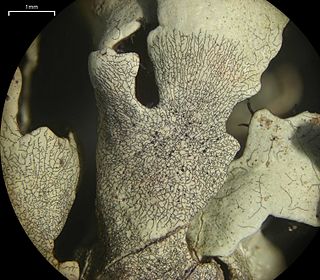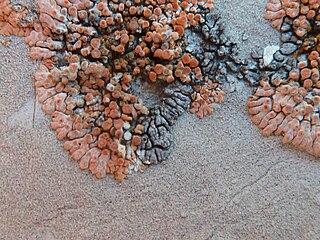
Verrucariaceae is a family of lichens and a few non-lichenised fungi in the order Verrucariales. The lichens have a wide variety of thallus forms, from crustose (crust-like) to foliose (bushy) and squamulose (scaly). Most of them grow on land, some in freshwater and a few in the sea. Many are free-living but there are some species that are parasites on other lichens, while one marine species always lives together with a leafy green alga.
Lichenochora is a genus of fungi in the family Phyllachoraceae. It has 44 species. All species in the genus are lichenicolous, meaning they grow parasitically on lichens. The genus was circumscribed by Josef Hafellner in 1989, with Lichenochora thallina assigned as the type species.

Endocarpon is a genus of saxicolous (rock-dwelling), crustose lichens in the family Verrucariaceae. The genus was circumscribed by German bryologist Johann Hedwig in 1789.
Clavascidium is a genus of lichens in the family Verrucariaceae. The genus was circumscribed in 1996 by Austrian lichenologist Othmar Breuss. Because the type species of the genus, Clavascidium umbrinum, has been shown using molecular phylogenetics to belong to genus Placidium, Cécile Gueidan and colleagues proposed to unite Clavascidium with Placidium in a 2009 publication. Despite this, the genus has been retained in recent publications of fungal classification.

Catapyrenium is a genus of lichens in the family Verrucariaceae. The genus was circumscribed by German botanist Julius von Flotow in 1850.
Bellemerella is a genus of fungi in the family Verrucariaceae. All four species are lichenicolous, meaning they grow parasitically on other lichens.
Anthracocarpon is a genus of lichen-forming fungi in the family Verrucariaceae. The genus was circumscribed by Austrian lichenologist Othmar Breuss in 1996 with Anthracocarpon virescens assigned as the type species.
Agonimia is a genus of lichen-forming fungi in the family Verrucariaceae.

Placidium is a genus of crustose to squamulose to almost foliose lichens. The genus is in the family Verrucariaceae. Most members grow on soil, but some grow on rock (saxicolous). The fruiting bodies are perithecia, flask-like structures immersed in the lichen body (thallus) with only the top opening visible, dotting the thallus. Lichen spot tests are all negative. Members of the genus lack rhizines, but otherwise resemble members of the genus Clavascidium.

Placidiopsis is a genus of lichens in the family Verrucariaceae. The genus was circumscribed by Italian naturalist Francesco Beltramini de Casati in 1858, with Placidiopsis grappae assigned as the type species.
Neocatapyrenium is a genus of squamulose lichens in the family Verrucariaceae. It has five species. The genus was circumscribed by Hiroshi Harada in 1993, with Neocatapyrenium cladonioideum assigned as the type species.

Heteroplacidium is a genus of lichen-forming fungi in the family Verrucariaceae. The genus was circumscribed by Austrian lichenologist Othmar Breuss in 1996 with Heteroplacidium imbricatum assigned as the type species. It was proposed as a segregate of Catapyrenium. Other morphologically similar genera are Neocatapyrenium, Placidium, and Scleropyrenium, although molecular phylogenetic analyses indicate that they are independent monophyletic lineages within the Verrucariaceae.
Henrica is a genus of crustose lichens in the family Verrucariaceae. It has four species. The genus was circumscribed by Maurice Bouly de Lesdain in 1921, with Henrica ramulosa assigned as the type species. The generic name Henrica honours Italian clergyman and lichenologist Joseph-Marie Henry (1870–1947).

Psoroglaena is a genus of lichen-forming fungi in the family Verrucariaceae. The genus was circumscribed by Johann Müller Argoviensis in 1891, with Psoroglaena cubensis assigned as the type species.
Sarcopyrenia is a genus of lichenicolous (lichen-dwelling) fungi. It has 11 species. It is the only genus in Sarcopyreniaceae, a family in the order Verrucariales. Sarcopyrenia was circumscribed by Finnish lichenologist William Nylander in 1858, with Sarcopyrenia gibba assigned as the type species. Sarcopyreniaceae is one of the few families composed entirely of lichenicolous fungi.

Lichenostigma is a genus of fungi. It includes several species which are lichenicolous.

Verrucula is a genus of lichenicolous (lichen-dwelling) lichens in the family Verrucariaceae. Species in the genus are parasitic on saxicolous (rock-dwelling), crustose lichens, including Xanthoria elegans as well as lichens from genus Caloplaca that contain chemical substances called anthraquinones.

Verruculopsis is a genus of saxicolous (rock-dwelling), crustose lichens in the family Verrucariaceae. It was circumscribed in 2007 by Cécile Gueidan, Pere Navarro-Rosinés, and Claude Roux, with Verruculopsis poeltiana assigned as the type species.

Catapyrenium boccanum is a species of squamulose (scaley), rock-dwelling lichen in the family Verrucariaceae. It grows on mortar or on calcareous rock. Its squamules are up to 4 mm wide, pale to dark brown with black margins and a black underside. Ascospores measure 11–15 by 5–8 μm. Because of its combination of squamulose thallus, simple ascospores, and lack of algae in the hymenium, this species is a "catapyrenioid" lichen, of which more than 80 exist in the Verrucariaceae.










